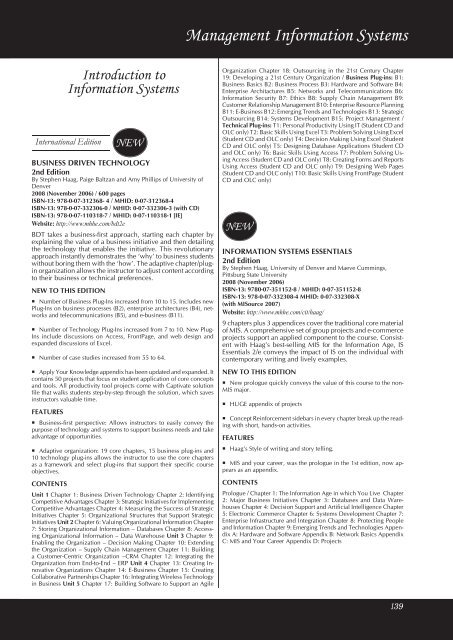Business Communication - McGraw-Hill Books
Business Communication - McGraw-Hill Books
Business Communication - McGraw-Hill Books
Create successful ePaper yourself
Turn your PDF publications into a flip-book with our unique Google optimized e-Paper software.
Management Information SystemsIntroduction toInformation SystemsInternational EditionNEWBUSINESS DRIVEN TECHNOLOGY2nd EditionBy Stephen Haag, Paige Baltzan and Amy Phillips of University ofDenver2008 (November 2006) / 600 pagesISBN-13: 978-0-07-312368- 4 / MHID: 0-07-312368-4ISBN-13: 978-0-07-332306-0 / MHID: 0-07-332306-3 (with CD)ISBN-13: 978-0-07-110318-7 / MHID: 0-07-110318-1 [IE]Website: http://www.mhhe.com/bdt2eBDT takes a business-first approach, starting each chapter byexplaining the value of a business initiative and then detailingthe technology that enables the initiative. This revolutionaryapproach instantly demonstrates the ‘why’ to business studentswithout boring them with the ‘how’. The adaptive chapter/pluginorganization allows the instructor to adjust content accordingto their business or technical preferences.NEW TO THIS EDITION• Number of <strong>Business</strong> Plug-Ins increased from 10 to 15. Includes newPlug-Ins on business processes (B2), enterprise architectures (B4), networksand telecommunications (B5), and e-business (B11).• Number of Technology Plug-Ins increased from 7 to 10. New Plug-Ins include discussions on Access, FrontPage, and web design andexpanded discussions of Excel.• Number of case studies increased from 55 to 64.• Apply Your Knowledge appendix has been updated and expanded. Itcontains 50 projects that focus on student application of core conceptsand tools. All productivity tool projects come with Captivate solutionfile that walks students step-by-step through the solution, which savesinstructors valuable time.FEATURES• <strong>Business</strong>-first perspective: Allows instructors to easily convey thepurpose of technology and systems to support business needs and takeadvantage of opportunities.• Adaptive organization: 19 core chapters, 15 business plug-ins and10 technology plug-ins allows the instructor to use the core chaptersas a framework and select plug-ins that support their specific courseobjectives.CONTENTSUnit 1 Chapter 1: <strong>Business</strong> Driven Technology Chapter 2: IdentifyingCompetitive Advantages Chapter 3: Strategic Initiatives for ImplementingCompetitive Advantages Chapter 4: Measuring the Success of StrategicInitiatives Chapter 5: Organizational Structures that Support StrategicInitiatives Unit 2 Chapter 6: Valuing Organizational Information Chapter7: Storing Organizational Information – Databases Chapter 8: AccessingOrganizational Information – Data Warehouse Unit 3 Chapter 9:Enabling the Organization – Decision Making Chapter 10: Extendingthe Organization – Supply Chain Management Chapter 11: Buildinga Customer-Centric Organization –CRM Chapter 12: Integrating theOrganization from End-to-End – ERP Unit 4 Chapter 13: Creating InnovativeOrganizations Chapter 14: E-<strong>Business</strong> Chapter 15: CreatingCollaborative Partnerships Chapter 16: Integrating Wireless Technologyin <strong>Business</strong> Unit 5 Chapter 17: Building Software to Support an AgileOrganization Chapter 18: Outsourcing in the 21st Century Chapter19: Developing a 21st Century Organization / <strong>Business</strong> Plug-ins: B1:<strong>Business</strong> Basics B2: <strong>Business</strong> Process B3: Hardware and Software B4:Enterprise Architactures B5: Networks and Telecommunications B6:Information Security B7: Ethics B8: Supply Chain Management B9:Customer Relationship Management B10: Enterprise Resource PlanningB11: E-<strong>Business</strong> B12: Emerging Trends and Technologies B13: StrategicOutsourcing B14: Systems Development B15: Project Management /Technical Plug-ins: T1: Personal Productivity Using IT (Student CD andOLC only) T2: Basic Skills Using Excel T3: Problem Solving Using Excel(Student CD and OLC only) T4: Decision Making Using Excel (StudentCD and OLC only) T5: Designing Database Applications (Student CDand OLC only) T6: Basic Skills Using Access T7: Problem Solving UsingAccess (Student CD and OLC only) T8: Creating Forms and ReportsUsing Access (Student CD and OLC only) T9: Designing Web Pages(Student CD and OLC only) T10: Basic Skills Using FrontPage (StudentCD and OLC only)NEWINFORMATION SYSTEMS ESSENTIALS2nd EditionBy Stephen Haag, University of Denver and Maeve Cummings,Pittsburg State University2008 (November 2006)ISBN-13: 9780-07-351152-8 / MHID: 0-07-351152-8ISBN-13: 978-0-07-332308-4 MHID: 0-07-332308-X(with MISource 2007)Website: http://www.mhhe.com/cit/haag/9 chapters plus 3 appendices cover the traditional core materialof MIS. A comprehensive set of group projects and e-commerceprojects support an applied component to the course. Consistentwith Haag’s best-selling MIS for the Information Age, ISEssentials 2/e conveys the impact of IS on the individual withcontemporary writing and lively examples.NEW TO THIS EDITION• New prologue quickly conveys the value of this course to the non-MIS major.• HUGE appendix of projects• Concept Reinforcement sidebars in every chapter break up the readingwith short, hands-on activities.FEATURES• Haag’s Style of writing and story telling.• MIS and your career, was the prologue in the 1st edition, now appearsas an appendix.CONTENTSPrologue / Chapter 1: The Information Age in which You Live Chapter2: Major <strong>Business</strong> Initiatives Chapter 3: Databases and Data WarehousesChapter 4: Decision Support and Artificial Intelligence Chapter5: Electronic Commerce Chapter 6: Systems Development Chapter 7:Enterprise Infrastructure and Integration Chapter 8: Protecting Peopleand Information Chapter 9: Emerging Trends and Technologies AppendixA: Hardware and Software Appendix B: Network Basics AppendixC: MIS and Your Career Appendix D: Projects139HED 2007 MIS.indd 13910/5/2006 2:04:09 PM

















